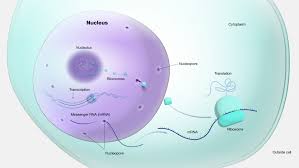What Is Nucleus

“What Is Nucleus: Everything You Need to Know”
The nucleus is often described as the control center of a cell, but what is nucleus beyond that simple description? From powering cellular functions to holding the genetic blueprint of life, the nucleus plays a crucial role in everything from growth and development to disease and evolution. In this comprehensive guide, we’ll explore the concept of the nucleus in depth—from its definition and historical evolution to its diverse functions, modern research, and its broader significance in science and everyday life. Whether you’re a biology student, a researcher, or simply curious about the building blocks of life, this article will provide you with everything you need to know about the nucleus.
Introduction
Imagine a tiny structure inside each cell of your body that contains all the instructions needed to build and maintain life—a mini command center that orchestrates growth, reproduction, and even repair. Did you know that the nucleus is not only found in the cells of plants and animals but is also a critical component in many microorganisms? Understanding what is nucleus is essential for grasping how life functions at the cellular level.
In this article, we will cover:
- Definition and Fundamentals: A clear, concise explanation of the nucleus and its essential characteristics.
- Historical Background: How our understanding of the nucleus has evolved over time, including key milestones and historical anecdotes.
- In-Depth Exploration: A detailed examination of the nucleus’s structure, functions, and types, with real-world examples and case studies.
- Significance and Applications: The importance of the nucleus in various domains such as biology, medicine, genetics, and biotechnology.
- Common Misconceptions and FAQs: Clarification of myths and answers to frequently asked questions.
- Modern Relevance and Trends: An overview of current research and debates related to the nucleus, and how new technologies are reshaping our understanding.
- Conclusion and Call-to-Action: A succinct summary of the key points and suggestions for further exploration.
By the end of this guide, you’ll have a thorough understanding of what is nucleus, why it is so vital to life, and how it continues to drive innovation and discovery in science and medicine. Let’s embark on this fascinating journey into the heart of the cell!
What Is Nucleus? A Straightforward Definition
The nucleus is a membrane-bound organelle found in eukaryotic cells that houses the cell’s genetic material—DNA—and is responsible for controlling cellular activities. It acts as the cell’s command center, directing growth, metabolism, and reproduction.
Essential Characteristics of the Nucleus
When considering what is nucleus, keep these key points in mind:
- Membrane-Bound Structure: The nucleus is enclosed by a double-layered membrane called the nuclear envelope, which contains nuclear pores that regulate the passage of molecules.
- Genetic Storage: It contains chromosomes, which are long strands of DNA organized with proteins. This genetic material carries all the instructions necessary for cell function and inheritance.
- Control Center: The nucleus regulates gene expression and cell function, controlling protein synthesis and cell division.
- Dynamic Structure: While the nucleus appears as a distinct, central organelle, its structure can change during the cell cycle, particularly during processes like mitosis.
- Presence in Eukaryotes: Only eukaryotic cells—cells with a defined nucleus—contain a nucleus, distinguishing them from prokaryotes (bacteria and archaea), which lack this organelle.
In essence, what is nucleus? It is the pivotal organelle within eukaryotic cells that stores genetic information and regulates the functions necessary for life.
Historical and Contextual Background
Understanding what is nucleus involves tracing its discovery and the evolution of our knowledge about this essential cell organelle.
Early Observations and Discoveries
The Dawn of Cellular Biology
- Robert Hooke and the “Cells”: In 1665, Robert Hooke used a primitive microscope to examine a thin slice of cork and coined the term “cells” after observing the small, box-like structures. Although these were dead cells, Hooke’s work sparked interest in the cellular structure of living organisms.
- Advances in Microscopy: Over the following centuries, improvements in microscope technology allowed scientists to observe living cells in greater detail, gradually revealing the complex inner structures of the cell.
The Discovery of the Nucleus
- Early 19th Century: The term “nucleus” was first used in the early 1800s by cell biologists who observed a prominent, dense structure in the center of plant and animal cells. It was recognized as a distinct entity within the cell.
- Schwann and Schleiden’s Cell Theory: The development of cell theory in the 1830s by Matthias Schleiden and Theodor Schwann established that all living organisms are composed of cells. This theory further emphasized the importance of the nucleus as a central, defining feature of eukaryotic cells.
Milestones in Nucleus Research
The Work of Rudolf Virchow
- “Omnis cellula e cellula”: In 1855, Rudolf Virchow famously declared, “Every cell arises from another cell,” highlighting the nucleus’s role in cell division and inheritance.
- Implications for Disease: Virchow’s insights laid the foundation for understanding the cellular basis of diseases, including cancer, where abnormalities in the nucleus play a critical role.
Modern Molecular Biology and Genetics
- Discovery of DNA: In the mid-20th century, the discovery of the structure of DNA by James Watson and Francis Crick transformed our understanding of the nucleus. DNA, housed within the nucleus, was identified as the molecule responsible for heredity.
- Advancements in Genetic Research: The advent of molecular biology techniques, such as DNA sequencing and gene editing (e.g., CRISPR), has enabled scientists to explore the functions of the nucleus in unprecedented detail.
Notable Historical Anecdotes
- Hooke’s Cork Cells: Although Hooke’s cells were dead, his observation of the cork’s structure was a crucial stepping stone in the development of cell theory.
- Virchow’s Contributions: Virchow’s work on cellular pathology established the nucleus as the central feature of life and disease, a concept that remains fundamental in modern medicine.
- The DNA Double Helix: The revelation of the DNA double helix in 1953 was a landmark moment that forever changed our understanding of the nucleus and its role in heredity and evolution.
In-Depth Exploration: Key Aspects and Functions of the Nucleus
To fully appreciate what is nucleus, we need to explore its structure, functions, and the various processes it governs within the cell.
1. Structural Features of the Nucleus
a. The Nuclear Envelope
- Description: The nuclear envelope is a double-membrane structure that encloses the nucleus, separating it from the cytoplasm. It is perforated by nuclear pores, which regulate the transport of molecules in and out of the nucleus.
- Function: This envelope protects the genetic material and maintains the distinct environment needed for DNA replication and transcription.
b. Chromatin and Chromosomes
- Chromatin: Inside the nucleus, DNA is packaged with proteins called histones to form chromatin. Chromatin can exist in two forms:
- Euchromatin: Loosely packed, gene-rich regions that are actively transcribed.
- Heterochromatin: Tightly packed regions that are generally inactive in gene transcription.
- Chromosomes: During cell division, chromatin condenses into visible chromosomes, ensuring accurate distribution of genetic material to daughter cells.
c. The Nucleolus
- Description: The nucleolus is a dense region within the nucleus where ribosomal RNA (rRNA) is synthesized and ribosome subunits are assembled.
- Function: It plays a critical role in protein synthesis by contributing to the formation of ribosomes.
2. Functional Roles of the Nucleus
a. Storage and Protection of Genetic Material
- DNA Repository: The nucleus houses the cell’s DNA, which contains all the instructions for building and maintaining the organism.
- Genetic Integrity: The nuclear envelope helps protect the DNA from damage and external threats.
b. Regulation of Gene Expression
- Transcription Control: The nucleus is the site of transcription, where DNA is transcribed into messenger RNA (mRNA). This process is tightly regulated by various proteins and transcription factors.
- Epigenetic Modifications: Chemical modifications to DNA and histones, such as methylation and acetylation, occur within the nucleus and play a crucial role in regulating gene expression without altering the DNA sequence.
c. Coordination of Cellular Activities
- Cell Cycle Regulation: The nucleus orchestrates cell division through the regulation of the cell cycle, ensuring that genetic material is accurately replicated and distributed during mitosis.
- Signal Integration: It integrates signals from various parts of the cell and the external environment, coordinating responses that affect cell growth, differentiation, and apoptosis (programmed cell death).
3. Real-World Examples and Case Studies
Case Study 1: The Role of the Nucleus in Cancer
- Overview: Abnormalities in the nucleus, such as mutations in DNA or defects in nuclear structure, are hallmarks of cancer.
- Application: Researchers study the nucleus to understand how genetic errors lead to uncontrolled cell division. Advances in nuclear imaging and genetic analysis have led to better diagnostic tools and targeted therapies.
- Impact: Improved understanding of nuclear function has resulted in significant breakthroughs in cancer treatment, including the development of drugs that specifically target cancerous cells’ nuclear processes.
Case Study 2: Nucleus in Stem Cell Research
- Overview: Stem cells have the unique ability to differentiate into various cell types, a process controlled by the nucleus.
- Application: Understanding how the nucleus regulates gene expression in stem cells is key to harnessing their potential for regenerative medicine and tissue engineering.
- Impact: Advances in nuclear biology have paved the way for innovative therapies aimed at repairing damaged tissues and treating degenerative diseases.
Case Study 3: Nucleolar Function and Protein Synthesis
- Overview: The nucleolus plays a critical role in ribosome biogenesis, which is essential for protein synthesis.
- Application: Research into nucleolar function has implications for understanding diseases linked to protein synthesis, such as certain genetic disorders and neurodegenerative diseases.
- Impact: Targeting nucleolar activity is emerging as a potential therapeutic strategy in the treatment of diseases where protein synthesis is disrupted.
Importance, Applications, and Benefits of Understanding the Nucleus
Understanding what is nucleus is essential not only for biology but also for a wide range of applications that impact medicine, genetics, and biotechnology.
1. Advancing Medical Science
- Cancer Research: A deep understanding of nuclear processes helps scientists develop targeted therapies to treat cancer by correcting or inhibiting faulty genetic expression.
- Genetic Disorders: Research into the nucleus has led to breakthroughs in diagnosing and treating genetic disorders, as many such conditions arise from defects in nuclear function.
2. Enhancing Biotechnology and Genetic Engineering
- CRISPR and Gene Editing: Modern gene-editing techniques, such as CRISPR-Cas9, operate within the nucleus to modify DNA sequences. Mastery of nuclear biology is critical for these cutting-edge technologies.
- Regenerative Medicine: Understanding how the nucleus controls cell differentiation and regeneration opens new avenues for tissue engineering and stem cell therapies.
3. Improving Education and Research
- STEM Education: The study of the nucleus is fundamental in biology and genetics. It forms a cornerstone of education in the life sciences, fostering critical thinking and scientific inquiry.
- Interdisciplinary Research: The nucleus connects various disciplines—molecular biology, biochemistry, genetics, and even medicine—making it a rich field for interdisciplinary collaboration and innovation.
4. Practical Applications in Daily Life
- Health Diagnostics: Techniques that analyze nuclear function, such as genetic testing and advanced imaging, are becoming increasingly important in preventive medicine and personalized healthcare.
- Biotechnology Products: Many biotechnology products, from pharmaceuticals to agricultural improvements, are based on advances in nuclear biology and genetic research.
Addressing Common Misconceptions and FAQs
Despite its critical role, several misconceptions about what is nucleus persist. Let’s clear up some of these misunderstandings:
Misconception 1: The Nucleus Is Just a Storage Container for DNA
- Clarification: While the nucleus does house DNA, it is much more dynamic—it regulates gene expression, controls cell division, and integrates signals from the cell’s environment.
Misconception 2: All Cells Have a Nucleus
- Clarification: Only eukaryotic cells contain a nucleus. Prokaryotic cells, such as bacteria, lack a membrane-bound nucleus, which is one of the key differences between these two types of cells.
Misconception 3: Nuclear Function Is Static Once Developed
- Clarification: The nucleus is a dynamic organelle. Its structure and function change throughout the cell cycle, and its activity is continuously regulated by internal and external signals.
Frequently Asked Questions (FAQs)
Q1: What is nucleus in simple terms?
A1: The nucleus is the control center of a cell, where genetic material (DNA) is stored and where key cellular processes, such as gene expression and cell division, are regulated.Q2: How does the nucleus differ from the cell’s other organelles?
A2: Unlike other organelles, the nucleus contains the cell’s genetic blueprint and is responsible for controlling most of the cell’s activities, making it central to cell function and reproduction.Q3: Why is the nucleus important for cell division?
A3: During cell division, the nucleus ensures that the genetic material is accurately replicated and evenly distributed to the daughter cells, which is crucial for the proper functioning of new cells.Q4: How is nuclear function studied in modern science?
A4: Scientists use advanced techniques such as fluorescence microscopy, genetic sequencing, and molecular imaging to study nuclear processes in real time.Q5: Can abnormalities in the nucleus lead to disease?
A5: Yes, defects in nuclear function can lead to a variety of diseases, including cancer and genetic disorders, making it a critical focus for medical research.
Modern Relevance and Current Trends
In today’s fast-evolving scientific landscape, the study of what is nucleus remains at the forefront of research and innovation. Here are some current trends and future directions in nuclear biology:
1. Advances in Genetic and Molecular Research
- Gene Editing Technologies: Tools like CRISPR-Cas9 are revolutionizing our ability to edit genes within the nucleus, opening up new possibilities in treating genetic disorders and advancing personalized medicine.
- Single-Cell Analysis: Cutting-edge techniques now allow researchers to study nuclear processes at the level of individual cells, providing insights into cell-to-cell variability and disease mechanisms.
2. Breakthroughs in Medical Diagnostics and Therapeutics
- Cancer Research: Understanding the intricacies of nuclear function is essential for developing targeted cancer therapies. Research on the nucleus is leading to innovative treatments that aim to correct or inhibit faulty genetic processes in cancer cells.
- Regenerative Medicine: Advances in stem cell research and tissue engineering rely on insights into nuclear mechanisms, which are crucial for controlling cell differentiation and regeneration.
3. Technological Innovations in Imaging and Analysis
- High-Resolution Microscopy: Technologies such as super-resolution microscopy and live-cell imaging allow scientists to observe the nucleus in unprecedented detail, furthering our understanding of its dynamic behavior.
- Computational Biology: The integration of computational methods with experimental data is enabling the modeling of nuclear processes, enhancing predictive capabilities and guiding new research directions.
4. Interdisciplinary Research and Applications
- Systems Biology: Researchers are now studying the nucleus as part of a complex network of cellular processes, leading to more holistic insights into how cells function and interact.
- Biotechnology and Industrial Applications: Advances in nuclear biology are influencing the development of new biotechnologies, including improved pharmaceuticals, diagnostic tools, and agricultural innovations.
Conclusion: Embracing the Central Role of the Nucleus
Our comprehensive exploration of what is nucleus has revealed that the nucleus is much more than a repository for genetic material—it is the dynamic, central hub that governs cell function, division, and communication. From its historical roots and groundbreaking discoveries to its modern applications in medicine, genetics, and biotechnology, the nucleus remains at the heart of biological research and innovation.
Key Takeaways:
- Definition: The nucleus is the control center of a cell, housing DNA and orchestrating critical cellular processes.
- Historical Evolution: The discovery and study of the nucleus have evolved from early microscopic observations to advanced molecular research, significantly enhancing our understanding of cell biology.
- Core Functions: The nucleus regulates gene expression, controls cell division, and maintains genetic integrity, playing a pivotal role in growth, development, and disease prevention.
- Modern Relevance: Technological advancements and interdisciplinary research continue to expand our knowledge of the nucleus, driving innovations in medicine, biotechnology, and genetics.
- Practical Benefits: Understanding the nucleus has profound implications for healthcare, scientific research, and everyday life, from cancer therapy to personalized medicine and beyond.
As you reflect on this guide, consider the remarkable role that the nucleus plays in every living cell—from the smallest bacterium to the most complex human tissues. Embracing the study of what is nucleus not only deepens our understanding of life at the cellular level but also empowers us to harness this knowledge for breakthroughs in science and medicine.
Call to Action:
- Join the Conversation: Share your thoughts, experiences, or questions about the nucleus in the comments below. How has learning about the nucleus influenced your perspective on biology or medicine?
- Share This Post: If you found this guide insightful, please share it on social media or with friends, colleagues, and anyone interested in exploring the fascinating world of cell biology.
- Keep Exploring: Continue your journey into the realms of genetics, molecular biology, and biotechnology by exploring additional resources, enrolling in online courses, and following the latest research on nuclear function and regulation.
Additional Resources
For further exploration of what is nucleus and its many facets, consider these reputable sources:
- Encyclopedia Britannica – Nucleus
- National Institutes of Health (NIH) – Cell and Molecular Biology
- MIT OpenCourseWare – Biology of the Cell
- Khan Academy – Introduction to Cells
- The American Society for Cell Biology
Final Thoughts
The nucleus is the heart of the cell—a dynamic, complex, and indispensable organelle that orchestrates life’s most fundamental processes. By understanding what is nucleus, we unlock the secrets of cellular function, paving the way for scientific innovations that improve health, enhance our understanding of genetics, and inspire countless discoveries. Whether you are a student delving into biology or a professional advancing in medical research, the study of the nucleus offers insights that are both profound and transformative.
Thank you for joining us on this comprehensive exploration of the nucleus. Stay curious, keep learning, and let the wonders of cellular biology inspire you to delve deeper into the mechanisms of life.
Recent Posts
- Geometry Regents Score Calculator (2025 NY Exam Tool)
- Algebra 2 Regents Score Calculator (2025 NY Exam Tool)
- Algebra 1 Regents Score Calculator (NY Regents Estimator)
- PreACT® Score Calculator (2025 Raw-to-Scaled Estimator)
- ACT® Score Calculator (2025 Raw-to-Scaled Score Tool)
- PSAT® Score Calculator (2025 Digital Exam Estimator Tool)
- AP® Music Theory Score Calculator (2025 Exam Estimator)
- AP® Art History Score Calculator (2025 Exam Estimator)
- AP® Spanish Literature Score Calculator (2025 Exam Tool)
- AP® Spanish Language Score Calculator (2025 Exam Tool)
- AP® Latin Score Calculator (2025 Exam Scoring Tool)
- AP® German Language Score Calculator (2025 Exam Tool)
- AP® French Language Score Calculator (2025 Exam Tool)
- AP® English Literature Score Calculator (2025 Exam Tool)
- AP® English Language Score Calculator (2025 Exam Tool)
Choose Topic
- ACT (17)
- AP (20)
- AP Art and Design (5)
- AP Chemistry (1)
- AP Physics 1 (1)
- AP Psychology (2025) (1)
- AP Score Calculators (35)
- AQA (5)
- Artificial intelligence (AI) (2)
- Banking and Finance (6)
- Biology (13)
- Business Ideas (68)
- Calculator (73)
- ChatGPT (1)
- Chemistry (3)
- Colleges Rankings (48)
- Computer Science (4)
- Conversion Tools (137)
- Cosmetic Procedures (50)
- Cryptocurrency (49)
- Digital SAT (3)
- Disease (393)
- Edexcel (4)
- English (1)
- Environmental Science (2)
- Etiology (7)
- Exam Updates (7)
- Finance (129)
- Fitness & Wellness (164)
- Free Learning Resources (208)
- GCSE (1)
- General Guides (40)
- Health (107)
- History and Social Sciences (152)
- IB (9)
- IGCSE (1)
- Image Converters (3)
- IMF (10)
- Math (44)
- Mental Health (58)
- News (9)
- OCR (1)
- Past Papers (450)
- Physics (5)
- Research Study (6)
- SAT (39)
- Schools (3)
- Sciences (1)
- Short Notes (5)
- Study Guides (28)
- Syllabus (19)
- Tools (1)
- Tutoring (1)
- What is? (312)
Recent Comments

What is Wireless Application Protocol

Williams Syndrome - Everything you need to know

Kidney Stones Causes - Everything you need to know

Progressive Supranuclear Palsy (PSP) - Everything you need to know




